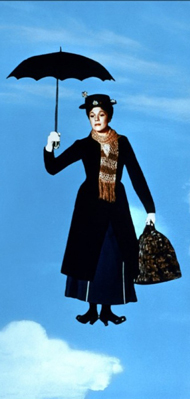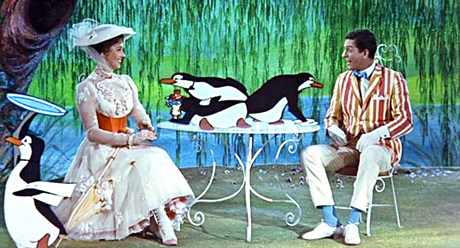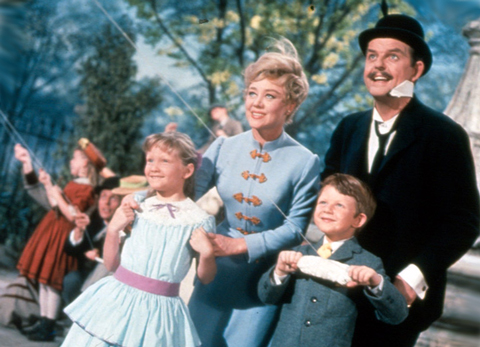Reviewed by Glenn Erickson
I don't think there was ever a time when Disney's Mary Poppins was uncool. This season The Mouse is making a major push on the classic film's behalf with Saving Mr. Banks, a picture I found to be pretty empty save for Tom Hanks' bright impersonation of Walt Disney. The foundation idea of Saving is that whatever Walt wants, Walt should get, and anybody who resists just needs a generous application of Disney magic to stop being an old crab apple. True or not, I found Ms. Travers' back story to be too much Psych 101 -- as if the naturally all-wise Disney is the perfect replacement for lost fathers, broken families, etc. Saving also oversells Mary Poppins as the greatest thing ever put on a movie screen, a completely unnecessary conceit. This story of the flying nanny is terrific, marvelous, a great time for young and old ... isn't that enough?
Disney's new 50th Anniversary Blu-ray of Mary Poppins is here a year early, but nobody's complaining. Just a couple of years before his death, Walt Disney assembled perhaps his best live action feature. He'd been making live-action films of all kinds for ten years. He'd conquered television and the big screen with just about every kind of picture suitable for family audiences. The economics of animated films had slowed his cartoon feature output considerably. One of the most popular films of its time, Mary Poppins showed the Disney organization to be capable of putting on a musical show equal to anything in the industry. It presented the enormously talented Broadway star Julie Andrews in her first movie, forever associating her and Dick Van Dyke with family fare. The family-film genre often reached no further than cute animals and mechanical sentiments, but the Disney team's keen story sense, musical dexterity and ease with whimsical magic brought class and charm to yet another children's classic. And the dancing penguins are perfect too.

The story concerns petty issues in a bourgeois London home. The Banks family has trouble retaining nannies due to the misbehavior of young Jane and Michael (Karen Dotrice and Matthew Garber). Their mother Winifred (Glynis Johns) is occupied outside the house with women's suffrage, and their workaholic father George (David Tomlinson) wants Jane and Michael to be barely seen and certainly not heard. Jane writes a fanciful poetic want ad for the perfect nanny. George tears it up, but the pieces reconfigure themselves to summon the magical Mary Poppins (Julie Andrews), a willful, exacting, softhearted martinet who dazzles the kids with feats of magic. Their neighborhood jaunts include visits with colorful characters like Bert the Chimneysweep (Dick Van Dyke), a whimsical cockney who shares Mary's connection with the fantastic.
I'm convinced that Mary Poppins is a superior picture, but my opinion is clouded by the fact that it completely charmed me when I saw it at about the age of twelve. I was just young enough to respond to its visual imagination in the correct spirit. This wasn't one of Disney's "shook-up shopping cart movies; everything about it pulled me in, especially a magical context that I later realized was provided by scores of expressive matte paintings. It wasn't until I saw the movie as an adult that I found out that Dick Van Dyke played a second role in old-age makeup.
Already known to theater and musical fans, Julie Andrews sprung up as the best Disney actor ever. She embodied every known virtue with the added benefit of being English. Disney had returned time and again to English settings for his movies -- he seemed to imagine the British as more civilized and 'special', a Midwesterner's idea of the exotic.
Buttressed by a great score of catchy ballads and ersatz music hall songs, Mary Poppins also has some deeper melodies that change its mood radically. The principal cast enjoys a fantastic trip to an animated world inside a sidewalk chalk painting, but there is also a strangely reverent song about feeding the birds, played out against a background of atmospheric matte paintings. A trip to Uncle Albert (Ed Wynn) finds us in a hilarious musical scene where laughter is its own motivation and its own reward.
Mary Poppins 'gets it right' in just about every aspect. The cute Banks children (Karen Dotrice & Matthew Garber) have actual personalities, which is more than can be said for the blonde ankle-biters in Chitty Chitty Bang Bang. Mother (Glynis Johns) is an addled suffragette, leading the housekeepers in chants for militancy (!) while seeing off the previous nanny, a washout (Elsa Lanchester). Father (David Tomlinson) is an annoying prig but a nice guy too, who merely needs to appreciate his family as being more than just a token of his status as a bank executive. 1
The Banks's little neighborhood is a mixture of stereotyped eccentrics given a veneer of storybook stylization. Admiral Boom (Reginald Owen) sets off a cannon to mark the time, a daily house-shaking event that all accept as business as usual (and which reminds us of similar slapstick gags in The Shaggy Dog. Off by the park entrance, the sweep Bert (Dick Van Dyke) makes chalk artwork and busks the crowds with songs that imply that he intuits a deeper, more magical reality afoot in London.

Disney's screenwriters and musicians prepare a terrific entrance for Mary Poppins, drifting down from the stratosphere on a magical umbrella to answer a small child's formula for a suitable, agreeable nanny. A dozen other nanny wannabes waiting outside the Banks house are blown away in the breeze like so many Fantasia pachyderms. Poppins retains a mysterious and unexplainable aspect throughout the picture. The first words said about her are to wonder that she might be a witch. Poppins has only to assert herself to seize the job. She makes almost no contact with the adults of the family while dazzling her moppet charges with feats of everyday magic -- sliding up the banister, cleaning a room by snapping her fingers, singing a duet with a robin.
Every episode is different and none are predictable. The unflappable Poppins provides an entertaining security blanket of reliable efficiency. The kids have their spirits lifted while the real problem in the family, the wet-blanket father, undergoes the most change by realigning his priorities so that just flying a kite (as suggested early on by Arthur Treacher's dour constable Jones) becomes an important bonding ritual. Poppins' purpose is only then made clear; with another family cured, she prepares to depart as mysteriously as she came. She's the Lone Ranger of domestic servants.
Why does Mary Poppins succeed where so many other family films fail, even many from Disney? The answer is commitment. Walt Disney made this film the way he tackled other big personal projects, like his early animated classics, his theme park Disneyland or his first live-action film 20,000 Leagues Under the Sea: making a commercial entertainment was never allowed to supercede making a superior one. The development time of two years was used for a lot more than having a screenwriter tinker with a script. Disney was able to juggle twenty projects at a time while having various departments of his studio attack a single project from multiple angles simultaneously. Art was being designed and songs written long before the plotline was nailed down, in many cases influencing the direction of the story. The artists didn't waste money, but if Disney wanted to make major changes halfway through a show, the expense didn't matter. Last-minute studio rescue jobs on ailing films rarely work, but Disney's changes were almost always beneficial. Knowing that their best efforts would be appreciated, his artisans continually outdid themselves. I know plenty of Hollywood artist-technicians. All they ever ask is to contribute to something, for their work not to be wasted.
A parting note: fans of Glynis Johns and David Tomlinson should check out the 1948 film Miranda, an engagingly frisky English comedy about a sex-mad mermaid's effect on several Londoners. You'll never again see the Disney film in exactly the same light. Mary Poppins ends up being as satisfying for adults as it is for little kids. Director Robert Stevenson made plenty of good movies before, and this is easily his best Disney film.

Disney's Blu-ray + DVD + Digital Copy of Mary Poppins presents this very special show in a new light. Even the enhanced widescreen 40th Anniversary DVD of nine years ago couldn't reproduce the movie's complex special effects without various 'issues' cropping up. The added resolution and contrast range of HD produces a much more impactful presentation. Colors are richer, while certain kinds of stylization (I'm thinking of the brush-stroke look of the artwork used in the "Feed the Birds" sequence) aren't allowed to blur. It isn't just the special effects that look more consistent. Scenes in the park now look deeper, with the trees and the mist between them seemingly going on for hundreds of feet.
Although I'm sure grain has been attacked here and there, the limitations of the original effects have not been painted over. We still see matte lines here and there, and can detect the grainy split screen work under the table below Poppins' bottomless carpetbag. And the little robot robin that greets Poppins is still a little clockwork toy -- no digital embellishments have been added. The Ellenshaw matte paintings look better than ever before -- they're reaching for a storybook look, not a photo-real one.
I've gotten several emails over the years asking about the audio on various discs of Mary Poppins. In particular, some readers were upset that I hadn't called out the 2004 DVD for what they thought was an altered soundtrack, with new sound effects added. Face it, if somebody alters a frame of Major Dundee I'm probably going to catch it. But Mary Poppins? After the first reel I become a completely uncritical, happy audience. But I do have a friend who is both an audio professional and a rapt fan of the Disney movie. He's followed the history of the releases of this particular title and volunteered to write up a little description of the history behind the new Blu-ray's impressive audio, at this footnote.
Two new extras are included. Becoming Mr. Sherman is a fourteen-minute tribute to composer Richard M. Sherman, who is interviewed by Jason Schwartzman, the actor who plays him in the new movie. And four Poppins tunes are given the sing-along treatment in the eight-minute extra Mary-Oke. Most of the extras from older releases are present. The main ones are a commentary with the Sherman Brothers, Julie Andrews, Dick Van Dyke, and Karen Dotrice. Disney on Broadway is a lengthy docu on the making of the Broadway adaptation. The Cat that Looked at a King is a short subject from 2004, with Julie Andrews and another chalk drawing adventure. Finally, "Backstage Disney" extras bring on a tall stack of making-of featurettes, and some musical featurettes have been retained as well, including the deleted song, "Chimpanzoo".
One extremely welcome aspect of the disc is how quickly one can navigate to the main feature. Just press 'Top Menu' and all the preamble stuff disappears. This is a big improvement over old Disney discs, which often forced parents to spend a two or three minutes setting up a show for their kids.
On a scale of Excellent, Good, Fair, and Poor,
Mary Poppins Blu-ray rates:
Movie: Excellent
Video: Excellent
Sound: Excellent
Audio: English 7.1, English, French, Spanish 5.1, original English mix
Supplements: Featurette Becoming Mr. Sherman; Mary-Oke singalongs; deleted song, reunion featurette; older 'archival' supplementary extras.
Deaf and Hearing-impaired Friendly?
YES; Subtitles: English, French, Spanish
Packaging: One Blu-ray and one DVD disc in keep case
Reviewed: December 10, 2013
Footnotes:
1. A full discussion of the audio of Mary Poppins, 12.10.13:
This first paragraph is from Wikipedia: "Mary Poppins was first released in the early 1980s on VHS, Beta, CED and laserdisc. From 1994 to 1999, it was re-released three times as part of the Walt Disney Masterpiece Collection. In 1998, this film became Disney's first DVD. In 2000, it was released on VHS and DVD as part of the Gold Classic Collection. In 2004, it had a 2-Disc DVD release in a Digitally Restored 40th Anniversary Edition as well as its final issue in the VHS Format. The film's audio track featured an "Enhanced Home Theater Mix" consisting of replaced sound effects (to make the soundtrack more "modern") and improved fidelity and mixing and some new music (this version is also shown whenever ABC Family airs the movie.) On January 27, 2009, the film was released on DVD again as a 45th anniversary edition, with more language tracks and special features."
The original theatrical 4-track audio is a wonderful mix, very distinctive.... with terrific orchestrations by Irwin Kostal (West Side Story and The Sound of Music). The instrumentation is bright and dry, sounding like a theatrical pit orchestra. The scoring was originally spread across the front three channels with dialogue and effects very tightly focused in the center channel. Very little activity in the rear channel... some orchestration and limited sound effects in the rear.
The early VHS and Laserdisc mixes folded this original 4-Track down to the Dolby Stereo matrix, which retained a nice bright balance, although less discrete as the matrix fold-down bled dialogue into the front left and right channels.
The first DVDs in 1998 and 2000 spread the original 4-Track across the front three channels, leaving left and right channels with the original dry, bright discrete orchestration, minus dialogue and effects. The first DVD draped more of the left and right front channels into the surround left and right channels, so there was actually a discrete left and right surround spread... that element was new but the overall effect was quite authentic. You could mute the center channel and essentially have a music-only track... practically no leakage of dialogue or effects into left and right channels.
The 2004 DVD introduced the "Enhanced Home Theater Mix" which added some new Foley effects, presumably to modernize the sound to be more active. I mean it clubbed you over the head with cartoon effects that didn't match the ambience of the production track... it was unwatchable for me. Also the 2004 EQ pumped up the bass, rolled off the top and added reverb too, all of which obscured the orchestrations slightly. This enhanced track also added a noticeable amount of reverb to the previously dry orchestrations and enhanced the bass register. They pulled some occasional distortion or damage out of the track as well, or possibly masked it with the reverb.
However, instead of retaining the original 1964 theatrical mix as a 5.1 track, the 2004 DVD provided it as a Dolby 2-Track matrix mix... and again the matrix bleeds dialogue into the front left and right channels. It doesn't have the width or dynamic range that it used to have.
I think they have toned down the enhanced Foley for this new Blu-ray release, because it really isn't that noticeable now, whereas to me it really jumped out on the 2004 DVD. I don't have that disc any more; I got rid of it because it annoyed me so much... so I can't compare. But I don't hear any obviously annoying new Foley now. So maybe they toned it down as Universal did with Vertigo.
The new Blu-ray appears to have expanded the 2004 Enhanced Home Theater Mix by further draping the surround sound to two more tracks along the side, but the overall characteristics remain the same. There's also a Dolby Digital 5.1 version of the enhanced mix. And again the original theatrical mix is only provided in the form of the Dolby 2-Track matrix. Purists that prefer the bright, dry and discrete theatrical sound of the original 4-track are out of luck, but at least the 5.1 is closer to the original this time.
Return

DVD Savant Text © Copyright 2013 Glenn Erickson
See more exclusive reviews on the Savant Main Page.
Reviews on the Savant main site have additional credits information and are often updated and annotated with reader input and graphics.
Also, don't forget the
2011 Savant Wish List.
T'was Ever Thus.
Return to Top of Page
|


